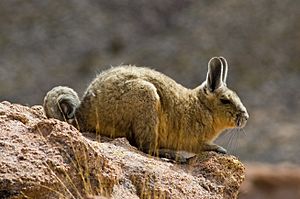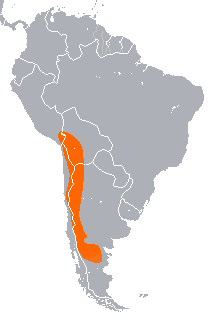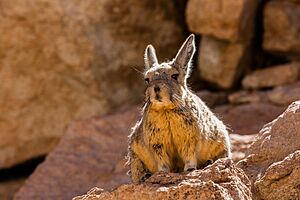Southern viscacha facts for kids
Quick facts for kids Southern viscacha |
|
|---|---|
 |
|
| Conservation status | |
| Scientific classification | |
| Genus: |
Lagidium
|
| Species: |
viscacia
|
The southern viscacha (Lagidium viscacia) is a cool rodent that looks a bit like a rabbit, but it's actually more closely related to chinchillas! You can find these furry animals living in the rocky mountains of Argentina, Bolivia, Chile, and Peru. They live together in small groups, kind of like a family, in their mountain homes.
Contents
What Does a Southern Viscacha Look Like?
The southern viscacha has soft, yellowish-grey fur on its back and lighter fur underneath. Its long, bushy tail has a black tip. They have long, furry ears with a white edge, and both their front and back legs have four toes.
Their feet have special fleshy pads called "pallipes." These pads help them move easily and quickly over rough, rocky surfaces. An adult southern viscacha usually weighs about 3 kg (6.6 lb).
These animals are also amazing climbers! They can climb straight up rocky walls. They can jump really far too, often more than five meters (16 feet) across. When jumping down, they can drop over fifteen meters (49 feet) from small ledges to narrow rocks.
Where Do Southern Viscachas Live?
The southern viscacha lives in the mountains of western Argentina, southern Peru, western and central Bolivia, and northern and central Chile.
They make their homes among rocks and cliffs where there isn't much plant life. You can find them at very high places, from about 700 meters (2,300 feet) up to 5,100 meters (16,700 feet) above sea level.
How Do Southern Viscachas Behave?
Southern viscachas do not hibernate, which means they don't sleep through the winter. They are most active in the early morning, right after the sun comes up, and again in the evening.
During these times, they come out of their hidden spots underground to find food. They mostly eat plants like grasses and moss, and they also enjoy lichens. A big part of their day is spent sitting on rocks, soaking up the sun, cleaning their fur, or just resting.
Southern viscachas live in groups and always stay close to rocks. This way, if they sense danger, they can quickly dive underground to safety. They use different sounds to talk to each other. One of their main predators is the Andean mountain cat (Leopardus jacobitus), which often hunts them for food.
Reproduction and Life Cycle
Southern viscachas usually start breeding in the last few months of the year. After mating, the mother carries her baby for about 130 days.
They usually have one baby, but sometimes two. The baby is born with its eyes open and fully covered in fur. This is called being "precocial." The young viscacha drinks its mother's milk for about eight weeks, but it can start eating solid food just hours after it's born!
We don't know exactly how long they live in the wild. However, one southern viscacha lived for 19 years while cared for by humans.
What is Their Status?
The southern viscacha is a common animal and there are many of them in some areas. However, their numbers can change a lot because of bad weather.
People sometimes hunt them for their meat and fur. But this hunting isn't happening so much that it causes their numbers to drop too low. Because of this, the IUCN (International Union for Conservation of Nature) lists the southern viscacha as a species of Least Concern. This means they are not currently in danger of disappearing.




